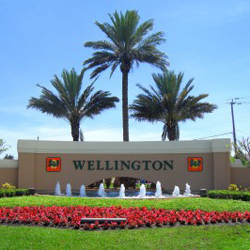Wellington has halted all canal clearing until it gets more information on the controversial project, which has drawn complaints from some residents who say their back yards are unnecessarily being razed of foliage.
At the June 23 meeting of the Wellington Village Council, Councilman John McGovern asked about the status of the canal reclamation project. It had garnered a lot of negative feedback at a public input meeting May 27 attended by about 120 residents, leading the village to halt all canal and right-of-way clearing for the time being.
Village Manager Paul Schofield said that a video regarding the canal-clearing project is posted on the village’s web site at www.wellingtonfl.gov, as well as the village’s Channel 18.
The project has cleared about 8 miles of canals and easements, but ran into strong objections when it moved into the Paddock Park and Sugar Pond Manor neighborhoods, where some residents complained that gardens and landscaping were being removed unnecessarily.
“Where we stand is that all of the canal reclamation projects have been put on hold, which does not mean we’re doing no work on the canals,” Schofield said. “If there is a culvert that needs to be taken care of, we’re fixing that. We have met with Mock-Roos, an independent engineer, to come in and take a look at the means and method we’re using and provide for alternatives.”
Schofield said he plans to meet with representatives from other water control districts that use amphibious excavators to see if that is a potential alternative for clearing the canal banks, which was being done to enable land-based excavators to reach the canals to clear storm debris.
“We will come back to the council with alternatives, but for the foreseeable future, which is probably through the end of this year, the only time we’re going to be touching any vegetation on a canal is if it’s sitting over a water line or a sewer line, or if it’s an imminent danger,” he said. “Those projects are on hold, and they will not be restarted without public notification and without the council being fully aware. It will be on a public agenda.”
Village staff members have said that clearing the canals and easements is an effort to maintain a healthy environment for residents.
A part of the maintenance involves removing vegetation and other items that block access by clearing crews and equipment to the canals and along their banks. Keeping these waterways and banks clear is vital to enable the clearing of debris after serious storms, and also preventing the potential interruption or contamination of Wellington’s potable water supply.
The project began in 2008, when the village was mandated to reverse its drainage to the north, away from its previous outfall into the Arthur R. Marshall Loxahatchee National Wildlife Refuge. The canal rights of way needed to be restored to enable heavy equipment access to the canals to remove obstructions in the aftermath of a storm.
The first five phases of the project have been completed, and future phases would have to be approved by the council because contracts have not yet been awarded, Schofield said.
The project is part of the village’s surface water management program, which includes roadway, swale and culvert reconstruction, as well as canal clearing and maintenance, which has not been done for 30 years in some areas, and culverts are at the end of their useful life.
Inspections were done in 2009 that revealed clogged pipes and obstructed outfalls that limited the water-carrying capacity by half in some areas.
The village has already cleaned about 8 miles of canals, starting with the easiest projects, but it is now getting into more populated areas where dump trucks were needed to remove material.
The objective was to clear the canal banks to allow equipment access. Workers have used a barge with a loader to knock trees and brush into the canal and remove it using the barge.
The 25-foot right of way is owned by the village, and one tree or obstruction in that right of way could block access to several thousand feet of canal bank, according to a staff report. Of the approximately 300 homes along the canal banks in the current phase, about 140 have obstructions.








